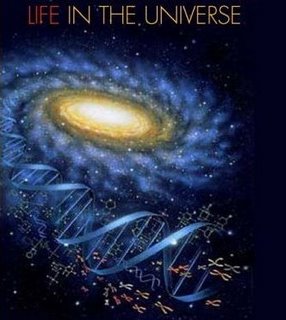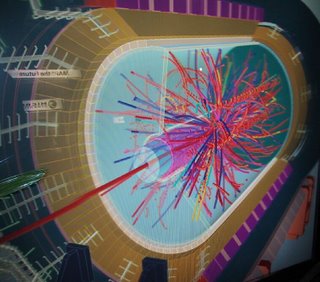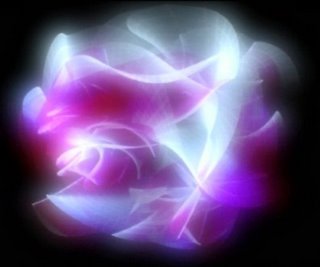Logic would dictate that just as there is space time, there is Space outside TIME.
In spacetime we can take a snapshot and freeze time, we can even rewind a film on video or dvd, but we do this travelling forward thru time. Even when we look at the distant stars and galaxies in the universe, we are looking at the light that reaches us on Earth, from a time long past.
Time (and even Space) as we shall see is relative to the observer, and as humans we are travelling thru time (and ageing over time).
It is movement that creates the impermanence of time, but there must be a Space outside Time where motion (or movement) is possible without decay, ageing, disease, suffering or death - among the multiverses that Leonard Susskind & Alex Vilenkin would like us to be aware of (see or imagine) - they seem to have ommited the one Above All where Time itself does not exist.
Just for a moment imagine yourself looking at a film of yourself on a 2D or 3D screen, now take a further step back and look at yourself in 3D+T (from outside Time).
Quasar9
Stephen Hawking has worked on the basic laws which govern the universe. With Roger Penrose he showed that Einstein's General Theory of Relativity implied space and time would have a beginning in the Big Bang and an end in black holes.
These results indicated it was necessary to unify General Relativity with Quantum Theory, the other great Scientific development of the first half of the 20th Century. One consequence of such a unification that he discovered was that black holes should not be completely black, but should emit radiation and eventually evaporate and disappear.
Another conjecture is that the universe has no edge or boundary in imaginary time. This would imply that the way the universe began can be completely determined by the laws of science.
Stephen HawkingWe live in the aftermath of a great explosion. This awesome event, called somewhat frivolously the big bang, took place about 14 billion years ago. We can actually see some of the cosmic history unfolding before us since that moment—light from remote galaxies takes billions of years to reach our telescopes on earth, so we can see galaxies as they were in their youth.
But there is a limit to how far we can see into space. Our horizon is set by the maximum distance light could have traveled since the big bang. Sources more distant than the horizon cannot be observed, simply because their light has not yet had time to reach Earth.
And if there are parts of the universe we cannot detect, who can resist wondering what they look like? Until recently physicists thought that the answer to this question is rather boring: it’s just more of the same – more galaxies, more stars. But now, recent developments in cosmology have led to a drastic revision of that view.
According to the new picture, distant parts of the universe are in the state of explosive, accelerated expansion, called “inflation”. The expansion is so fast that in a tiny fraction of a second a region the size of an atom is blown to dimensions much greater than the entire currently observable universe. The expansion is caused by a peculiar form of matter, called “false vacuum”, which produces a strong repulsive force.
The word “false” refers to the fact that, unlike the normal “true” vacuum, this type of vacuum is unstable and typically decays after a brief period of time, releasing a large amount of energy. The energy ignites a hot fireball of particles and radiation. This is what happened in our cosmic neighborhood 14 billion years ago – the event we refer to as the big bang.
With inflation, the two competing processes are the decay of the false vacuum and its “reproduction” by rapid expansion of the inflating regions. My calculations, and those of Andrei Linde, show that false-vacuum regions multiply much faster than they decay, and thus their volume grows without bound.
At this very moment, some distant parts of the universe are undergoing exponential inflationary expansion. Other regions like ours, where inflation has ended, are also constantly being produced. They form “island universes” in the inflating sea of false vacuum. Because of inflation, the space between the islands rapidly expands, making room for more island universes to form.
Inflation is thus a runaway process that has stopped in our neighborhood, but still continues in other parts of the universe, causing them to expand at a furious rate and constantly spawning new island universes like our own. This never ending process is referred to as “eternal inflation”.
The role of the big bang in this scenario is played by the decay of the false vacuum. It is no longer a one-time event in our past: multiple bangs went off before it in remote parts of the universe, and countless others will erupt elsewhere in the future.
Analysis shows that the boundaries of island universes expand faster than the speed of light. (Einstein’s ban on super-luminal speeds applies to material bodies, but not to geometric entities such as the boundary of an island.) It follows that, regrettably, we will never be able to travel to another island, or even send a message there. Other island universes are unobservable, even in principle.
In the global view of eternal inflation, the boundaries of island universes are the regions where big bangs are happening right now. Newly formed islands are microscopically small, but they grow without limit as they get older. Central parts of large island universes are very old: big bangs once took place there long time ago. Now they are dark and barren: all stars have long since died there. But regions at the periphery of the islands are new and must be teeming with shining stars.
The inhabitants of island universes, like us, see a different picture. They do not perceive their universe as a finite island. For them it appears as a self-contained, infinite universe. That dramatic difference in perspective is a consequence of the differences imposed by the ways of keeping time appropriate to the global and internal views of the island universe. (According to Einstein's theory of relativity, time is not fixed, but instead is observer dependent.)
Perhaps the easiest way to see this is to count galaxies. In the global view, new galaxies are continually formed near the expanding boundaries, so as time passes, we have an infinite number of galaxies in the limit. In the internal view, all this infinity of galaxies exists simultaneously (say, at time 14 billion years). The implications are extraordinary.
Since each island universe is infinite from the viewpoint of its inhabitants, it can be divided into an infinite number of regions having the same size as our own observable region. My collaborator Jaume Garriga and I call them O-regions for short. As it happens, the most distant objects visible from Earth are about 40 billion light-years away, so the diameter of our own O-region is twice that number.
Quantum fluctuations in the course of eternal inflation ensure that all possible values of the constants are realized somewhere in the universe. As a result, remote regions of the universe may drastically differ in their properties from our observable region. The values of the constants in our vicinity are determined partly by chance and partly by how suitable they are for the evolution of life. The latter effect is called anthropic selection.
Another recent application of the principle of mediocrity, unrelated to string theory, is to the amount of dark matter in the universe. As its name suggests, dark matter cannot be seen directly, but its presence is manifested by the gravitational pull it exerts on visible objects. The composition of dark matter is unknown. One of the best motivated hypotheses is that it is made up of very light particles called axions. The density of axionic dark matter is set by quantum fluctuations during inflation and varies from one place in the universe to another.
Alex VilenkinHowever, it is clear that just as photons can be in many possible places but are only actually in one, we as humans though we can potentially be in many places are only actually ever in one, and that one place will be wherever we happen to be in 1) our physical body, and 2) our mind or mental state.
All our other states in Vilenkin's multiverses are effectively or conceptually in a different time frame, or outside Time - but they are unlikely to be at the same time. After all we can talk to many people in an auditorium or through tv, but we can only ever hold a one to one with one person at a time, and a dialogue or conversation with a few at most - even during video conferencing.

















One interesting question, connected to the scope of Lisa’s talk, is: “If there is new physics, but it lies at a higher energy scale than the one directly accessible by the machine, how do we maximize our chances to see it ?”
Historically, the reason that black holes appear so promising as compared with other possible signatures is the predicted huge cross section for their production if there is a low quantum gravity scale. Lisa ventured to compute that if quantum gravity turns on at a scale of a TeV, one gets 100 pb which for 100 fb-1 luminosity would yield ten million events.
The basic reason why this cross section is so large compared to the production of a particle with TeV mass in a typical beyond the SM theory is the lack of any small couplings, such as gauge couplings in the cross section and absence of phase space suppression factors. However, this estimate ignores several major considerations and uncertainties in the black hole production and decay cross sections.
There is no suppression from gauge couplings, so it is indeed a large signal. Also, the signature is spectacular, since these objects are predicted to decay into large multiplicity final state, with highly spherical distributions. Very distinctive, unmistakable new physics.
But the problem is that the idyllic picture is not very realistic. The onset of a non-perturbative regime where black holes are produced and decay with those signatures is much above the QG scale, and this appears to be above the reach of even the LHC.
The Large Hadron Collider (LHC) at CERN has not emitted the first burp yet, and it is already criticized for being a midget. In any case, at threshold one would not see the striking signatures, but maybe something can be saved.
You have to go well above M, the energy scale of quantum gravity, to be sure to hit the striking signatures publicized in the past. The parton distribution functions of the proton drop rapidly with the fraction of parton momentum, and since we are by necessity near threshold, the value of the latter is very important in determining what the rate of the new process is going to be. To make matters worse, M is convention-dependent. Factors of - fly around easily, and although one knows these are only conventions and what one cares for is just the actual threshold, there is a big difference between 1 TeV and 2 TeV for the LHC. So the picture is fuzzy.
Bubble Chamber: Leonard Susskind & Lisa Randall
Lisa discussed some of the models and the resulting conventions and equations for the schwarzschild radius, the energy scale, and the other main characteristics.
One point which looked important is that in the models considered, the black hole lifetime is bigger than the inverse of the energy scale of quantum gravity. This drives some of the phenomenology of the black hole decay. Another point is that every degree of freedom should carry an insignificant amount of energy with respect to the total; and since we are never going to get far above threshold at the LHC, we will have to be careful to call what we produce a real classical black hole. These things have low entropy close to threshold, and the multiplicity of the decay will be affected.
A critical factor in the computation of the number of particles emitted in the black hole decay is the assumption of the dimensionality of the space: particles emitted in the bulk have more directions in which to oscillate. Furthermore, since the threshold for producing black holes is not M, but a higher energy, even if we did see a black hole, we would not be able to extract M from the total cross section, because of inelasticity effects: not all the energy of the colliding partons goes in the creation of the black hole, due to initial state radiation.
The difficult question to answer is in fact, what fraction of the energy gets trapped inside the horizon? It is of course important since the PDF fall rapidly with energy. What is clear is that the inelasticity effectively increases the threshold. The reduction in cross section due to this effect is enormous, and it is the lack of considering it, which has brought some overoptimistic predictions in the past.
So, the upshot is that BH production threshold is higher than originally thought. It means a lower production cross section, a lower reach in black hole mass, and it translates into lower entropy reach as well. The conclusion of Lisa Randall is that we will not produce classical thermal black holes at the LHC. What will we still be able to produce, then ? And what kind of multiplicities should we expect ?
Lisa discussed the calculation of the multiplicity of final state particles. She said that the calculation is totally unreliable. But one thing stays clear: low multiplicity final states will dominate even if we call it black holes. So we have to face the facts, and study 2-body final states: jets and leptons. Can they be distinguished from backgrounds by rate, kinematics, bra size? Yes. For jets, transversality is the key. QCD is dominated by t-channel exchange, i.e., forward scattering. Black hole events are isotropic. So this is really becoming like any other compositeness search: massive states produced at low rapidity.
While describing a scenario where the LHC will have to walk the walk of unclear kinematical analyses rather than being hit in the face by those firework-like signatures that experimentalists have started to dream more and more frequently as of late, Randall was careful to insist that the LHC is indeed a powerful machine, although she fell short of declaring it will make everything clear about quantum gravity.
After discussing the signature of black holes, Randall delved into the possible signatures of the same kind from alternative models of quantum gravity, such as a weakly coupled string theory. There one apparently expects a resonance behaviour, followed by a dramatic drop in transverse cross section, which can be used to distinguish the stringy behavior from the simple production of a new Z’ boson, ...
In addition to the resonance, you would also see a drop in the quantity. This could also allow to distinguish models: you could decide you are finding a stringy state, and you could even distinguish different stringy models, because the correlation between and the cross section is different for different models. In summary, black holes are not as spectacular as advertised in the past. However, they may still provide lots of information about quantum gravity, through careful studies of processes.
Lisa also said she would love to see these studies done by Atlas and CMS: energy-dependent angle studies in dijet production.
Tommaso Dorigo asked the question: "I know from previous blogging on the issue that when one reaches a quantum gravity regime, the QCD cross section of dijet production has to go down, but Lisa had not discussed this feature." She explained that before one reaches the regime when QCD 2-particle cross section gets reduced, the cross section has to go up, in any case. So the dijet cross section reduction that Sabine has first studied happens at a regime that LHC will fail to cover.
Source: Lisa Randall: black holes out of reach of LHC
by Tommaso Dorigo @ A Quantum Diaries Survivor.
_________________________________________________________
_________________________________________________________
Lisa Randall: Unification in warped extra dimensions and bulk holography
Lisa Randall: Smashing open the Universe @ Prospect Magazine.
Event probability for Production of Single Top Quarks using Matrix Elements